#historic streetcar
Explore tagged Tumblr posts
Text

"Bumblebee" historic streetcar, San Francisco
22 notes
·
View notes
Text
Sunnyside Streetcar, ca. 1926
View from SE 33rd Ave and Belmont St. Portland City Archives, AP/54825 Click here to view the image on Efiles.

View On WordPress
0 notes
Photo

Muni streetcar no. 1079 arriving at Noe & Morket on a gray morning.
1 note
·
View note
Text
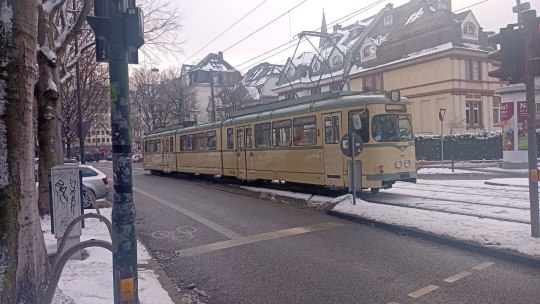
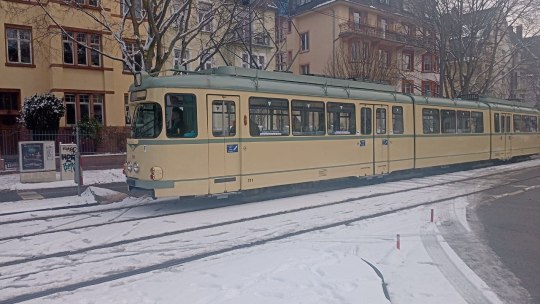
A historic O-Series tram in the original 1960s livery that I saw yesterday in my neigbourhood.
0 notes
Text
The suburbs kinda suck, and you should stop moving there when you have kids. Kids being able to go places is actually really good for their development and there are no shops or 3rd places in the Suburbs. Just think, if you had a kid would you rather live in a cool canopied historic streetcar suburb with a corner store down the street and an ice cream place a few blocks away or would you want to live on a hot miserable suburb where you can't walk anywhere but other people's houses
3K notes
·
View notes
Text

Cable Cars, San Francisco, United States: The San Francisco cable car system is the world's last manually operated cable car system and an icon of the city of San Francisco. San Francisco's cable cars are listed on the National Register of Historic Places and is one of only two street railways to be named a National Historic Landmark, along with the St. Charles Streetcar Line in New Orleans. Wikipedia
198 notes
·
View notes
Text

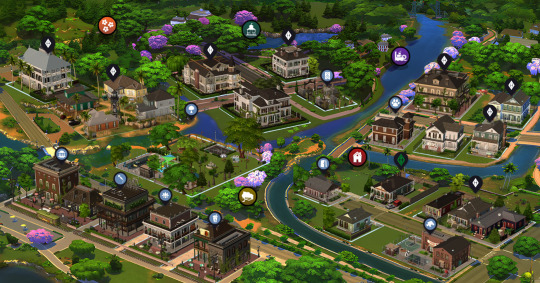
Willow Creek Map Key
Crawdad Quarter
Willow Historical Society & streetcar depot- History Museum
Ellington's Jazz Lounge- Live music lounge
Ally's Boutique Salon- Salon, spa and clothing shop
Bayou Sentinel & Antiques- Local newspaper office, archives and thriftea shop
Magnolia Municipal Park- Local park, family splash park and Krazy Kajun food stand
Foundry Cove
YSAC (Young Sims Activity Center)- Community Center
Crick Convenience & Drug- 24 hour convenience store
20-24 Foundry Dr.
25 Foundry Dr.
26 Foundry Dr.
Courtyard Lane
Firehouse Vet & Pet Park- Veterinarian's office & pet training gym
Laissez Terrace- Bohemian Bean Cafe, 5 apartments and 738 Courtyard Ln.
731 Courtyard Ln.
732-734 Courtyard Ln.
733 Courtyard Ln.
Pendula View
Quiet Voices Memorial- Cemetery, speakeasy and nightclub
Lakeside Manor
Leonard-Montgomery House
Magnolia Estate
Sage Estates
Mariner's Outlook
Sage Beach Community- Shore House, Sea Esta, Ocean Pearl, Second Wind
#neighborhood save#the neighborhood save#sims 4#ts4#sims community#ts4 simblr#simblr#ts4 build#sims build#sims save file#sims map#save file progress#save file#ts4 builds#the sims#ts4 save file#ts4 willow creek#willow creek
284 notes
·
View notes
Text
Most dogs are trapped in an endless loop of boredom. After millennia of hanging out in the wild, they're now stuck in suburbia. Just like their so-called best friend, the human, dogs yearn for stimulation that they're not getting in their off-eggshell-white, HOA-controlled economic-efficiency prisons. In recent history, these stimuli used to come from long rides in cars, but with the price of gas, and especially the death of our beloved Saab Automobile AB, who can afford to just drive their dog around while they bark at weird birds they see on the highway?
In the modern era, the rapid development of "dog parks" has attempted to provide a substitute to the demanding dog. No roar of engines, sure, but you get to run around a bit, maybe bite a Little League player. Unfortunately, dog parks are expensive to safely fence, and the poop has lots of negative impacts on the local real estate market, which we have collectively decided is the most important thing in existence and should be the sole survivor of our civilization, the only mark in the historical record that we were ever here. So they get turned into luxury condos.
Trains would be an option for the bored pooch-about-town, had we thought to build them. Dogs are notoriously enthusiastic about steam locomotives in particular, a fact which alternately thrills and horrifies animal psychologists the world over. Electric less so: the inverter whine hurts their little ears, and most of those run underground, where the only thing to bark at is weird rats. No fun at all. Streetcars, you ask? Don't make me laugh. You know what happened to that clown college at the bottom of the hill.
There is, however, hope. At the pet store, I have just now found this rubber bee that squeaks when you squeeze it. I am assured that it is the end of dog boredom for all eternity, or at least until my miniature Pomeranian, Ripper, tears the squeaker out and pukes it up on my duvet at 3:15 in the morning. Don't thank me: I'm just doing my part for all of dogkind.
121 notes
·
View notes
Text
Alastor - Historical Trivia And Headcanons

Alastor was a mixed-race Creole man living in New Orleans, and was in his 30's/40's when he died in 1933. We don't know much else about him, but historical context can provide us with possible additional details:
The population of New Orleans in 1930 was 458,762, more than it is now. 27.2% of the people were black, 3.1% were foreign-born, and roughly half of America's bipoc population was unemployed thanks to the Great Depression. New Orleans' original Francophonication was still strong, and it was common to run into locals who only spoke French dialects (Cajun French, Louisiana Creole). The city has had a huge Chinatown, a small Little Italy, and multiple other districts known for their immigrant African/colonized French cultures.
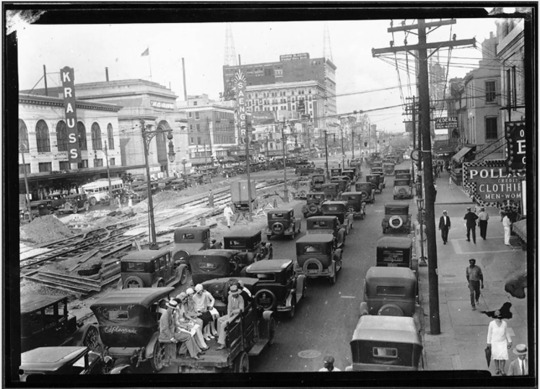
The Jim Crow laws were heavily enforced, as was the 'One Drop' rule. If Alastor was a mixed race black man, he would not have been able to attend a white school, use the same public transport, and would have shopped at black-local stores and restaurants under threat of violence. If he was mixed with any other race, some Jim Crow laws didn't apply, but state or city laws might specify differently.
Just because Alastor wears a suit, it doesn't mean he was rich in life. Radio personalities often didn't earn a fortune. Unless he owned his own broadcast, he was paid by a private company for long shifts of hosting music, news, and radio plays. In 1930, 40% of households owned at least one radio, which means that a popular radio host would have been easily recognized.
If he was in his late 30's in 1933, he might have fought in WW1, so long as he was over the age of 21. Some cities gave veterans small benefits, or encouraged the community to give them jobs. This often did not include veterans of color.
New Orleans was famous for being one of the least Christian cities in America, thanks to its unique immigrant and slave population. Haitian-based faiths and practices (such as voudo), indigenous cultures, Asian Buddhism, and atheism were common. But Christianity was still the official, law-enforced religion. Schooling involved reading the Bible, laws were sworn to Jesus, etc.
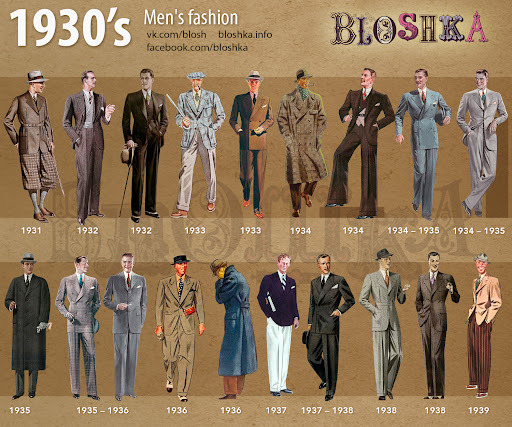
Alastor's outfit in Hazbin Hotel isn't very accurate to real-life American men's fashions of the time. Back then, deviating from the norm with the smallest detail would have stuck out like a sore thumb - like his white-lined lapels. Men always wore a hat. They were allowed to go without a waistcoat, but not a jacket. Belts were becoming more popular than suspenders. The silhouette was bulkier than the slimmer, Italian cuts of our modern times, especially the pants. Hair was kept short, and oiled down in a side part. Americans preferred the clean shaven look. Ties were essential unless you were a blue-collar laborer. Colors were almost universally muted neutral tones for everyday wear. The most colorful textiles for men were sporting outfits, like a tennis jacket.
If Alastor was a middle-class single man, he likely would have lived in an inner-city apartment, in an ethnic neighborhood. He probably didn't own a car, and took public transit like the streetcars. If he owned a house, it would likely have been an inheritance, and even the more opulent houses of the time would have looked small and plain to our eyes.
Because of the Great Depression, unmarried men were becoming the norm, rather than the exception. Men of the community who were sought after but remained single were suspect to gossip, but less ire than you might think; in the '30s, American queer culture was going through a very sharp revival, escaping the rigid Victorian era and before the puritan 40's/50's. But as a mixed-race man, it may have been illegal for a white woman to marry him, as the Jim Crow laws forbade the marriage of white people and Black/Asian people.
A middle class city household would have had electricity, gas heating, indoor plumbing, but may not have had running taps or a gas stove. Even with decent means, Alastor might have been using a potbelly woodburning stove, a dry sink/washbasin, wooden bathtub, and did his own laundry instead of sending it to the neighborhood laundresses. He may or may not have bothered with an icebox. Fresh groceries needed to be cooked and eaten soon, as things like pasteurized milk or store refrigeration wasn't a thing.
If he had enough money, then he almost certainly hired maids or other servants. Whether the maid came over just once a week, or did the shopping and laundry every other day, hired help was much more common back then, especially if he had no wife.
The most popular musicians in 1933 were Bing Crosby, George Olsen, and Leo Reisman. As you might have noticed, it was trendy for the lead singer to be backed by an orchestra, not a 'band' of just four other people like today. The most popular radio shows were Dick Tracy, Sherlock Holmes, and Doc Savage. They were recordings the radio station would buy and then broadcast, or sometimes the actors were live on the air. The radio host was usually not the journalist - the production team was responsible for writing his script.
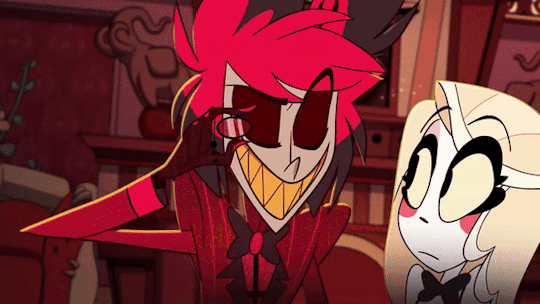
#alastor#alastor the radio demon#hazbin hotel#hazbin alastor#alastor headcanons#hazbin hotel headcanon
116 notes
·
View notes
Note
🔥
America could rapidly transform its cities into urban paradises if it simultaneously (a) privatized every street (b) required that commute time be counted and paid as if it was time spent working.
Everybody forgets that the much-ballyhooed trams/streetcars in America were privately owned and operated. But historically, most streetcar operators had signed contracts with cities to cover street maintenance costs, so when cars became popular, suddenly streetcar companies found themselves paying for the massive amount of wear and tear that cars cause to the road—effectively, subsidizing their own competition.
I say: bring that back! Privatize the roads and give them total freedom with the requirement that the owner pay all maintenance costs on a regular basis. They'd quickly figure out that lowering maintenance costs (banning cars) while still increasing usage (encouraging dense, efficient transit like streetcars) would be the way to go.
Couple that with requiring businesses to pay workers for their commute times, and most businesses would start putting immense pressure on other institutions to shorten commutes... encouraging dense, urban living.
There, I just pissed off both the Marxists and the capitalists following me. This is the perfect post because I get to be right and everybody else gets to be unhappy.
136 notes
·
View notes
Text


From a 1953 ad: "In Atlanta more people travel transit than in most cities"!
A friend sent me this fascinating clipping from 1953, touting Atlanta's transit system. It comes from the Southern Israelite (weekly), May 15, 1953.
It reads:
"In Atlanta more people travel transit than in most cities | A study of 15 other cities with populations similar to Atlanta's shows that the number of rides on Atlanta's transit system per capita is greater than that of any city in the list, except only one."
"In 1952 the average Atlantan rode with us 184 times. The average person on the other 15 systems rode only 134 times -- 27% less than Atlanta!"
"Although the number of autos in Atlanta has doubled since 1946, the number of rides per capita has decreased only 38%. The average decrease in the other cities was 43% and in one 59%."
"So, while we've lost a lot of riders -- just as every other transit system in the country has -- our loss has been far smaller. And we attribute that to the fact that Atlanta has one of the nation's finest transit systems."
The photo in the ad shows a trolleybus. Streetcars that ran on tracks were phased out in 1949 in Atlanta, leaving the overhead wires in use by only trackless trolleys, or trolleybuses. The last run of a trolleybus in Atlanta was in 1963.
The history of mass transit in Atlanta reaches back to the mule-drawn streetcars of 1871. The city once had an extensive system of electric streetcars, with rail that reached out as far as Marietta. Many of our intown neighborhoods developed originally as streetcar suburbs of the historic Downtown commercial area.
It's important to remind ourselves that Atlanta has been a "car town" only for part of its history. It was a trolley town for a long time. Hopefully we're heading into a future where the city's transportation mix has lower focus on personal car ownership and a higher one on transit, walking, and cycling.
26 notes
·
View notes
Text
LIMAX
I’m tired, I’m bored, let’s talk about the RE18, also sometimes known as LiMAX or Drielandentrein (three countries train).
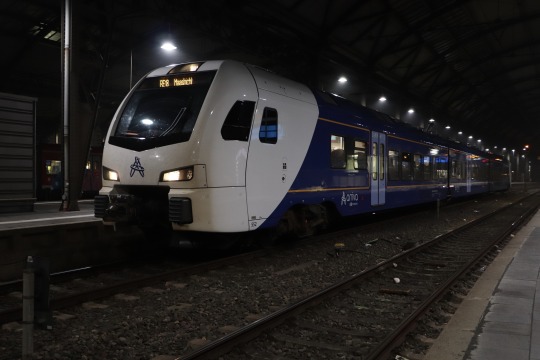
Euregio
This international regional train connects the region known as Euregio Maas-Rhine, the area around the point where Netherlands, Belgium and Germany meet. The region has a long shared and sometimes weird history. The main cities are Aachen (Germany, about 260,000 inhabitants), Liège (Belgium, about 200,000 people) and Maastricht (Netherlands, about 120,000 folks). A cluster of smaller towns around Heerlen (Netherlands, 86,000 citizens) forms a fourth major pole. Each of the regions gets roughly around half a million inhabitants each, but with a lot of green space in between. Here's a very crude map:

Blue are borders, black are relevant passenger rail lines, red is the one high speed line I'll talk about later.
This region is either right in the centre of Europe, or at the periphery of each of its respective countries, depending on what aspect you look at. Centre of Europe is undeniably better, but it requires international cooperation to work out. For me, living in Aachen, it’s great. My nearest Ikea is in the Netherlands, and I can watch French movies in cinemas in Liège.
But a lot of things aren't perfect, and the regional rail connections are a good example. Differing ticketing systems mean that it's not only expensive to cross the border, it's often very difficult to figure out what it costs at all. In a lot of places, trains only did short hops over the border, and then you had to change to a different train to get anywhere interesting. Some lines weren't even electrified yet. But in 2018, that was all about to change.
LIMAX
The Liège-Maastricht-Aachen express, in short LIMAX, was meant to change all that. The train is officially known as RE 18, which comes from the numbering scheme in the German state of Northrhine-Westphalia but is used for the entire route. It was supposed to run from Liège via Maastricht and Heerlen to Aachen, connecting all the major cities of the Euregio.
This particular train is a dutch project, and connecting Aachen with Liège only happens incidentally. There is a direct Aachen-Liège railway line, actually the oldest international line that’s still in use, including the oldest surviving German railway tunnel, and there is even a high-speed line that bypasses around 90% of the historic line. You can get from Aachen to Liège in less than half an hour on high speed trains (though regional trains are weird and impractical at the moment). This train line is really more about getting people in Heerlen a direct link to Liège, and people in Maastricht a direct link to Aachen.
The train
The train is operated by Arriva Netherlands Limburg, an independent subsidiary of Deutsche Bahn, who also operate all other rail and bus lines in the southern half of the dutch province of Limburg. They were actually placed second in the tender for this, but got promoted after it turned out that the actual winner Abellio (a daughter of the dutch state railroads NS) had illegal access to internal documents of previous operator and third-place scorer Veolia from France. To their credit, this came out because Abellio management learned of it and made it public, but rules are rules, so they still got disqualified. This is barely in the top three most interesting stories with Abellio, but we don’t have time for that here.
The service uses Stadler FLIRT 3 electric multiple units. FLIRT is an abbreviation, but nobody bothers remembering what it stands for. The manufacturer also offers or used to offer the TANGO (streetcar), the WINK (smaller version of the FLIRT), KISS (double-decker) and their newest high-speed train, the… SMILE. Cowards.
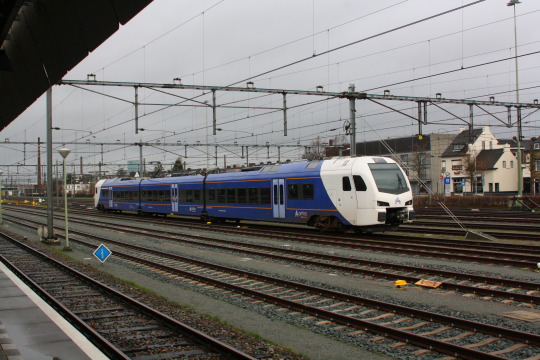
The FLIRTs for this service are specially equipped for the line, supporting all the different voltages in the overhead lines and all the other necessary support systems… almost. That’s going to become important later.
(Arriva Nederland Limburgs also has other trains, including other FLIRTs, that are only equipped for the Netherlands. I'll ignore them here.)
Services started in December 2018, theoretically. In practice the German leg of the service didn’t work yet. The problem was that the line from Heerlen to Herzogenrath (and then further to Aachen) used to be one of the few non-electrified lines in the region. It was electrified specifically for the RE18, and the work wasn’t quite finished yet. That got resolved, though, and the train is now working mostly well between Germany and the Netherlands. There are still some issues, like how it consistently announces that the doors will open on the left when they will open on the right and vice versa, but those are minor issues. The main problem for me is that it bypasses the Ikea station instead of stopping there.
The much bigger problem was the Belgian line, from (south of) Maastricht to Liège. The Belgian railway authorities were never that enthusiastic about the project to begin with, seeing how it was a private dutch company (though owned by the German government), and the platforms in the intermediate station of Visé were too low for step-free access and needed to be rebuilt. But the real main issue lay elsewhere: The new trains did not have ETCS.
Train control systems
We need a detour here about train control systems. Trains are controlled by signals. If a train passes a red signal, an accident usually follows, so over time every country developed different systems to make sure that doesn’t happen. The specific features of these vary widely. Some just warn the engineer that a red signal is ahead, and stop the train if the engineer doesn’t react. Some activate the emergency brake when the engineer passes a red signal, or when they don’t brake enough. More advanced ones for high speed lines tell the engineer the current allowed speed, upcoming speed changes and how far away they are, like a mini-GPS system, and constantly check that the engineer is driving within these limits. Many systems do a combination of different things.
Almost every country has its own of these systems, generally known by a cryptic abbrevation, and many countries have several. For example, Germany has PZB for all lines and additionally LZB for high-speed lines. The Netherlands have different versions of ATB, Belgium has TBL1+ and so on. The differences between them aren’t relevant for this post, but they’re all very different in what they do and how they do it. The RE 18 trains support all of them, except LZB because they’re not used on lines that make it necessary.
That’s expensive and annoying, so the European Union and European rail industries have developed a new system to replace all of them, the European Train Control System or ETCS. You will also hear the term ERTMS (European rail traffic management system), which includes ETCS and some other things, but in common parlance it usually means the same thing. Despite the name, it is also heavily used outside of Europe, e.g. on China’s high speed rail network.
And yes, that is very much a situation like the classic XKCD comic:
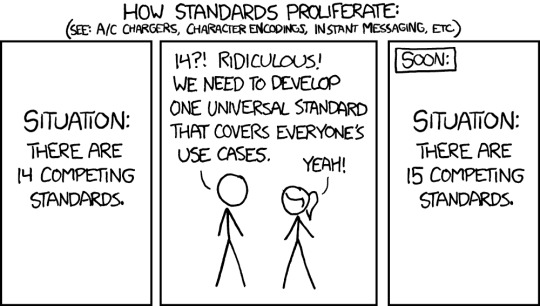
Source: XKCD 927, CC-BY-NC 2.5
(For americans reading this and wondering about PTC: That is a whole mess and almost everyone, including Wikipedia, explains it wrong, but for the purposes of this post we can just say that these systems and in particular ETCS are all something „like“ PTC.)
ETCS will only make sense once all European mainlines are equipped with it, which is still several decades away. But some countries are working harder than others to implement it. In particular, Belgium demands that all new trains since about 2015 have ETCS. Including the Stadler FLIRT for the RE 18.
In this case
The operator protested, because that requirement apparently came in while the trains were in production, and the line in question didn’t even have ETCS at the time (according to the latest Belgian maps it does now). To this day, the trains actually running there, as a Liège-Maastricht shuttle, do not have ETCS. So clearly it's not that essential… yet. Still, Belgian authorities refused to budge, so the trains had to be sent back to the manufacturer to get ETCS installed.
(Aside: ETCS is an open standard, and you can get ETCS equipment both for the tracks and for the trains from many different companies. Stadler, the manufacturer of these trains, only recently got into making ETCS equipment. Before that they had to buy it from competing train makers. These trains are among the first equipped with Stadler’s ETCS solution.)
The first train got it installed, returned to the line, and started tests. It worked well in the Netherlands, it worked well in Germany, it ran into Aachen station and worked well there, it ran back out of Aachen station and it stopped. Full emergency stop. After some testing it was determined that it always does an emergency stop when running out of Aachen station. And nobody is really sure why.
The low-down
We can make some vague guesses, though, because Aachen main station does have some ETCS equipment.

ETCS works partially with radio, but also with what are functionally giant RFID tags, the same basic concept like what you’ll find on a wireless credit card. They’re working at different frequencies and they’re designed for reliable reading at 450 km/h, but the basic idea is pretty much the same. These tags, known as „Balise“ (French for beacon) or Eurobalise, are mounted in the middle of the track, and are often yellow, at least when new. They can either send the same data every time, or be controlled with a cable from a computer.
Not everybody loves ETCS, but everybody seems to like the Eurobalise. It’s simple technology that can transmit a lot of information, and so there are a number of non-ETCS uses for it.
One such use case is transmitting the information of an older train control system. That is what the Belgians do with their TBL1+ system. It’s the same system as TBL1 (there is also a TBL2, but that was a bad idea and is gone now), but it transmits its information with Eurobalises. The idea is that you update these balises later to also transmit ETCS signals. Older trains can just get a balise reader, newer trains can just get ETCS, and you have only a single type of thing in the track instead of two. Switzerland is the first country that is fully ETCS equipped thanks to such a strategy, and Belgium is following suit.
The other use case is the "ETCS-based class B transition". Sounds tough but really isn’t: ETCS has a mechanism to tell the train, "hey, ETCS is ending, switch to ATB/PZB/TBL/…". In this context "Class B" means any system that isn’t ETCS (and that is on the list of things that ETCS knows about, for this purpose). The system ensures that the train really does switch to the other system, and that it stops if the switch doesn’t work. That is very useful and so most border crossings at least in Germany use it these days, even if no other part of ETCS is seen anywhere.
Both of these use cases are well established and ETCS specifically allows for them. Aachen central station is particularly fun because here you will find both of them combined. It is the border station for (passenger) trains to Belgium, so several tracks can be switched to Belgium mode, with Belgian electricity, and with Belgian TBL1+ train control system. The Eurobalises in these tracks pull double duty: They tell trains whether to switch to Belgian or German train control systems, depending on where the route is set, and if the Belgian system is to be used, they also transmit the information from that.
This isn’t new, and has worked well for years. The only other two types of passenger trains approved for the Netherlands, Belgium and Germany (and in one case also France), the Thalys PBKA and the ICE 3M high speed trains, also run through this station and they also have ETCS equipment and it all works.
But something about the combination together with the ETCS equipment in the new trains just doesn’t mesh well. It’s possible that there’s a bug in the software of the train. It’s possible that there’s a bug in the coding of the balises. Maybe it's something else; ETCS is a complex standard with a lot of updates, and the equipment in Aachen hasn't been touched in a while.
A theory I read on a dutch forum said that these balises tell the train to switch to combined PZB+LZB mode, but the train only has PZB mode and gets confused. I don’t know enough about ETCS to know whether this is plausible (and I know way too much about this stupid system already). All we really know for sure is that there are people working on this, and they're not telling us any of the details.
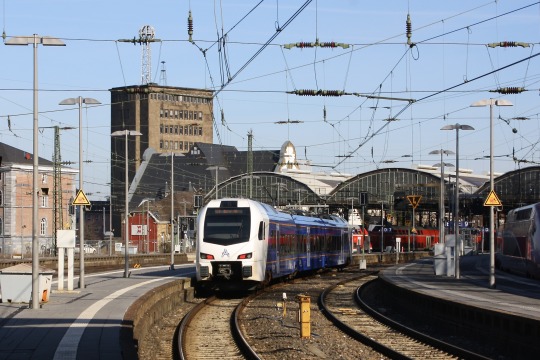
But after a few days where the train just didn’t run to Aachen at all, they found a solution. You know how I said that some tracks can be switched to Belgium mode? The others can’t, so why not just run the train into those?
That was actually easier said than done. Aachen has a lot of tracks, but most of them are used for parking trains. Most German regional trains to Aachen end in Aachen, and then wait here for half an hour or so until they return to where they came from. This isn’t required by the track layout or anything, it’s just convenient because that way, delays don’t build up quite as much. And the best location for that pause is, of course, right at the edge of the country. Centre of Europe? Yeah, sure, whatever…
So the solution is now that the RE18 runs into track 3 and stops in the middle of the platform, where it unloads all passengers. Then it drives forward to the end of the platform, and stays there. Another train, the RB33, pulls in behind it (there’s a red signal between them, don’t worry), and waits for its time to depart. Eventually it does, and shortly thereafter, the RE18 runs back to the middle of the platform, and then a few minutes later, back out again. It’s a silly little dance, but so far nobody has found a better solution.
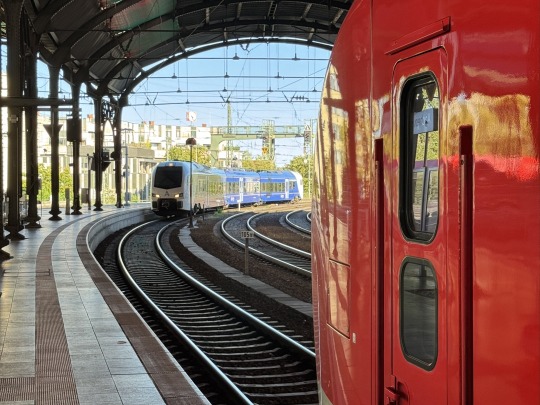
(Before you start, the end of platform 3 is very narrow and at a non-accessible height, so the train can't just load and unload there.)
As for the Belgian side of things, through-services to Liège will start this December! Woohoo! It seems this thing is finally working.
The Future
The long-term hope is to turn this from an hourly to a half-hourly service. It already is for most of its length, but right now the trains stop in Herzogenrath, just after the German border, because there is no space in the schedule to run them to Aachen yet.
Another hope is to create a completely new service from Aachen to Eindhoven, also using the same trains. Eindhoven wants to be connected to the German ICE network, Aachen wants to be connected to the dutch train network, so this sounds all great. Personally, I have doubt that these trains have enough capacity, but they are currently the only ones that would work. An issue with that is the actual line over the border. This used to be double-tracked, then got single-tracked. Now they want to double-track it again, but when it was electrified, they put the power poles right where the second track used to be. Not sure what they were thinking there.
All of these projects will take years, if not decades, and have in fact already taken years or decades. I’ve been in Aachen since 2007, and things like electrifying the line over the german-dutch border or creating a direct train from Aachen to the center of the Netherlands (or at least Eindhoven) have been in discussion for at least since then. On the one hand, it’s frustrating how slowly all these things are going. On the other, they are happening at all, and looking back ten years or so, it’s quite nice to see what has been accomplished.
I guess my one wish is that they’d finally let the train stop in Heerlen Woonboulevard, I’m tired of changing trains to get to Ikea.
118 notes
·
View notes
Text

One of San Francisco’s historic F-line streetcars at night.
20 notes
·
View notes
Text
95th Academy Awards: Oscars Trivia!
Another torturously long awards season is over! A24's highest-grossing film ever, Everything Everywhere All at Once, defied almost every piece of popular wisdom about the Academy Awards and easily cleared every hurdle in its path to a blowout, historic Best Picture win.
As you probably know, I'm a sucker for Oscar trivia, and this year has plenty of juicy nuggets to dig into. Let's get to it, starting with our newest Best Picture winner.
Everything Everywhere All at Once is the third film in Oscar history to win three of the four acting categories, after A Streetcar Named Desire (1951) and Network (1976). All three films won Best Actress and Best Supporting Actress. Everything Everywhere All at Once is the only film of the three that managed to win Best Picture.
Michelle Yeoh is the first Malaysian actress, first Asian actress, and second woman of color to win Best Actress. This is only the thirteenth time that Best Actress and Best Picture have overlapped in the 95-year history of the Oscars. Yeoh's nomination made her the first Asian actress nominated for the award since 1935. The only other is Merle Oberon, who hid her Asian identity in life and passed as white.
Everything Everywhere All at Once is the first science-fiction film to win Best Picture.
Everything Everywhere All at Once is the first Best Picture winner with a woman of color (Michelle Yeoh) in the lead role.
Having opened in theaters in late March 2022 (the same weekend of the 94th Academy Awards), Everything Everywhere All at Once is the Best Picture winner with the earliest calendar release since The Silence of the Lambs, which opened Valentine's Day 1991.
Everything Everywhere All at Once is the third Best Picture winner with a majority non-white cast (after 2016's Moonlight and 2019's Parasite) and the first American film with a majority Asian cast.
Daniel Kwan and Daniel Scheinert (Everything Everywhere All at Once) are the third directing team to win Best Director, joining Jerome Robbins and Robert Wise (West Side Story, 1961) and Joel Coen and Ethan Coen (No Country for Old Men, 2007). Kwan is also the fourth Asian director (and first Asian-American) to win Best Director.
Everything Everywhere All at Once is the first movie in 95 years of Oscars history to win six(!) so-called "above the line" awards -- referring to Best Picture, Director, the four acting categories, and the two writing categories.
Everything Everywhere All at Once is the first film to sweep the four primary guild awards (Producers Guild, Directors Guild, Writers Guild, and Screen Actors Guild) since Argo (2012), and only the fifth overall.
Some crazy coincidences between Michelle Yeoh and her Best Actress presenter Halle Berry: in addition to currently being the only two women of color to win Best Actress, they are also both former Bond girls (Yeoh in Tomorrow Never Dies [1997], Berry in Die Another Day [2002], both with Pierce Brosnan). Additionally, both women are former contestants of the Miss World pageant: Berry represented the United States in 1986, while Yeoh represented Malaysia in 1983. Also, in a weird case of history rhyming, both Berry and Yeoh won over a previous Oscar-winner in a film directed by Todd Field (Sissy Spacek in In the Bedroom in 2001, Cate Blanchett in TÁR in 2022).
With four wins, All Quiet on the Western Front tied with Parasite (2019), Roma (2018), Crouching Tiger, Hidden Dragon (2000), and Fanny and Alexander (1982) as the most-rewarded non-English language films in Oscars history.
This is also the second time that Cate Blanchett has won a Golden Globe, a BAFTA, and a Critics Choice Award for a performance, only to lose the Oscar to the lead of the Best Picture winner. The other time this happened was the year another comedy won seven Oscars: Shakespeare in Love. Blanchett, who was nominated for Elizabeth that year, lost to Gwyneth Paltrow.
TÁR brought Blanchett her eighth Oscar nomination, tying her as the fourth most-nominated actress in Oscar history. Only Bette Davis (10), Katharine Hepburn (12), and Meryl Streep (21) are ahead of her.
TÁR is only director Todd Field's third feature (after 2001's In the Bedroom and 2006's Little Children), but all three of his films have gotten Best Actress nominations for their leads.
Blanchett has also extended her record as the Oscar-nominated actress with the most appearances in films nominated for Best Picture. With TÁR, she has now appeared in 10 Best Picture nominees.
Tom Hanks (who turned in one of the weirdest performances ever caught on film in Elvis) also crossed the 10 Best Picture appearance threshold with this year's nominations. The only nominated actor with more Best Picture appearances is Jack Nicholson, who's been in 11.
This year's nominations saw a record-breaking number of Asian actors nominated: Yeoh in Best Actress, Ke Huy Quan (Everything Everywhere All at Once) in Best Supporting Actor, and Hong Chau (The Whale) and Stephanie Hsu (Everything Everywhere All at Once) in Best Supporting Actress. Yeoh and Quan won, marking the first time multiple Asian actors have won in a single ceremony.
Hong Chau (The Whale) is the first Oscar-nominated actor to be born in a refugee camp.
This year also saw a record number of Irish actors nominated in a single year, with five: Colin Farrell (The Banshees of Inisherin) and Paul Mescal (Aftersun) in Best Actor, Brendan Gleeson and Barry Keoghan (both from The Banshees of Inisherin) in Best Supporting Actor, and Kerry Condon (again, The Banshees of Inisherin) in Best Supporting Actress.
It was a banner year for Ireland in other categories, too, with nominations in Best Live Action Short (An Irish Goodbye, which won the award) and in Best International Feature (The Quiet Girl, the first Irish-language film ever nominated for an Oscar).
With his win in the Supporting Actor category, Quan became only the second Asian actor to win that award, joining the late Haing S. Ngor, who won for his debut performance in The Killing Fields (1984).
All five of the nominees for Best Actor -- Austin Butler (Elvis), Colin Farrell (The Banshees of Inisherin), Brendan Fraser (The Whale), Paul Mescal (Aftersun), and Bill Nighy (Living) -- were first-time nominees. This is the first time this has happened in this category since 1934(!!!).
It was a huge year for first-time nominees across all four acting categories: 16(!) of the 20 actors nominated were first-timers. This is the most ever in a single year. The only actors with previous nominations were Cate Blanchett, Angela Bassett, Judd Hirsch, and Michelle Williams.
Jamie Lee Curtis (Everything Everywhere All at Once) is the third person to be nominated for an Oscar after both of her parents were nominated as well: her father Tony Curtis was nominated for The Defiant Ones (1958), while her mother Janet Leigh was nominated for Psycho (1960). The other sets of nominated parents and children are Liza Minnelli (with parents Judy Garland and Vincente Minnelli) and Laura Dern (with parents Diane Ladd and Bruce Dern). Minnelli, Dern, and Curtis all won acting Oscars.
With his performance in The Whale, Brendan Fraser became the first person to win Best Actor for a film not nominated for Best Picture since Jeff Bridges in Crazy Heart (2009).
This is also the first time since 2005 that all four acting winners were first-time nominees. Additionally, none of the four acting winners won in their category at the BAFTAs, which has never happened before.
With his Best Supporting Actor nomination, Judd Hirsch (The Fabelmans) broke the record for the longest gap between acting nominations: he was last nominated 42 years ago for Ordinary People (1980). The record previously belonged to Henry Fonda, who had a 41-year gap between nods.
In addition to being the first actor ever nominated for a performance in a Marvel movie, Angela Bassett (Black Panther: Wakanda Forever) also became the fourth Black actress to be nominated more than once. She joined Viola Davis, Whoopi Goldberg, and Octavia Spencer.
The Fabelmans is the first movie to win the Golden Globe for Best Picture - Drama to go home emptyhanded at the Oscars since The Turning Point (1977[!]). In fact, this is the first time ever that both Golden Globe Best Picture winners (The Fabelmans in Drama, The Banshees of Inisherin in Comedy) went home with zero Oscars.
2022 had some other similarities with 1977, too: this was the first year since 1977 that two films (Everything Everywhere All at Once and The Banshees of Inisherin in 2022, Julia and The Turning Point in 1977) got four individual acting nominations. Both years saw comedies win Best Picture and Best Actress (Annie Hall in 1977), and both years had a sci-fi blockbuster nominated in Best Picture (Star Wars and Avatar: The Way of Water).
Ana de Armas (Blonde) became the second actor nominated for playing Marilyn Monroe, which is more Oscars than Monroe herself was ever nominated for. She was nominated in Best Actress alongside Michelle Williams (The Fabelmans), the other actress nominated for playing the star (in 2011's My Week with Marilyn).
De Armas also became the fifth Latina nominated for Best Actress, joining Fernanda Montenegro, Salma Hayek, Catalina Sandino Moreno, and Yalitza Aparicio. She is also the second Cuban actor ever nominated, after Andy Garcia.
With her win for Black Panther: Wakanda Forever, legendary costume designer Ruth Carter became the first Black woman to win two Oscars — ever.
Only Austin Butler and Ana de Armas were nominated for playing historical figures this year. Weirdly, both Elvis and Blonde feature actor Xavier Samuel in small roles. What does it mean?
At 34 minutes long, The Boy, the Mole, the Fox and the Horse is the longest Best Animated Short winner ever.
In addition to being the first song from an Indian film to be nominated for and win the Oscar for Best Song, "Naatu Naatu" (RRR) is the fourth non-English language winner of that award, after "Never on Sunday" (1960, originally performed in Greek), "Al otro lado del río" (2004, in Spanish), and "Jai Ho" (2008, in Hindi, Urdu, and Punjabi). "Naatu Naatu" is in Telugu.
It was the year of the sequel: between Avatar: The Way of Water and Top Gun: Maverick, this marked the first time multiple sequels were nominated in Best Picture in the same year. Black Panther: Wakanda Forever and Glass Onion: A Knives Out Mystery also received major nominations.
Avatar and Top Gun also marked the first time since 1982 that the two highest-grossing films of the year were both nominated for Best Picture.
#oscar trivia#oscars#oscars trivia#academy awards#trivia#movies#everything everywhere all at once#michelle yeoh#daniel kwan#daniel scheinert#ke huy quan#jamie lee curtis#brendan fraser#the whale#top gun: maverick#naatu naatu#rrr#the fabelmans#the banshees of inisherin#avatar: the way of water#angela bassett#cate blanchett#all quiet on the western front
376 notes
·
View notes
Text
How do you get an audience that has been historically excluded from Broadway to feel welcome at your show? You invite them. You make them feel like they have space. I’ve been paying attention to see if there’s a night when people are not talking to each other, and it hasn’t happened yet. People want to feel like they can kick back and be themselves. The show is giving people permission to do that in the experience of Juicy suddenly looking at you and saying, “What do you think?” Now, you’re like, “Oh, I actually can be responsive to this, because he’s asking me questions. He wants to know what I think, and how do I tell ’em what I think? I laugh, I cry. I go, uh-oh.” That starts to happen the moment they realize that there is no fourth wall.
Why don’t you like the fourth wall? It’s just not as fun. Having no fourth wall allows the world to be bigger. There’s a set of plays where it works really well. Most of Chekhov is great, even though one could make the case that there’s no fourth wall in Chekhov. Ibsen for sure. A Streetcar Named Desire needs the safety of being behind the fourth wall because it goes to some really awful places. So you need that protection.
But there’s no fourth wall in Shakespeare, and there’s no fourth wall in the Greeks. It’s not as common as we pretend it is, even though we have all these theaters that are built for plays that have four walls. Saying I don’t like the fourth wall is me being in line with the vast majority of theatrical history.
182 notes
·
View notes
Text
Remember what was taken from you by the car companies to boost profits
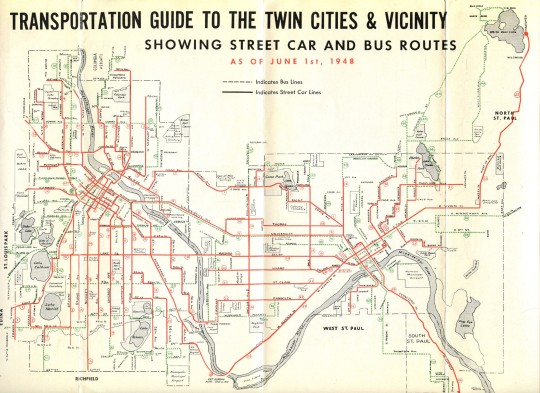


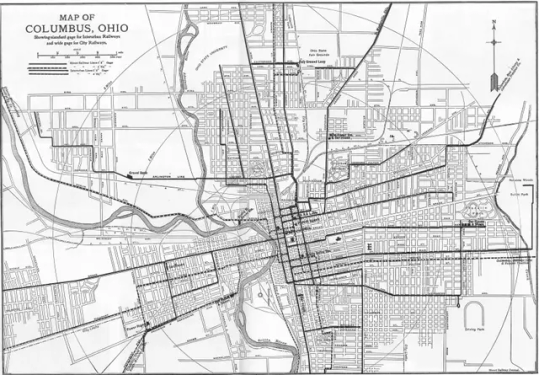
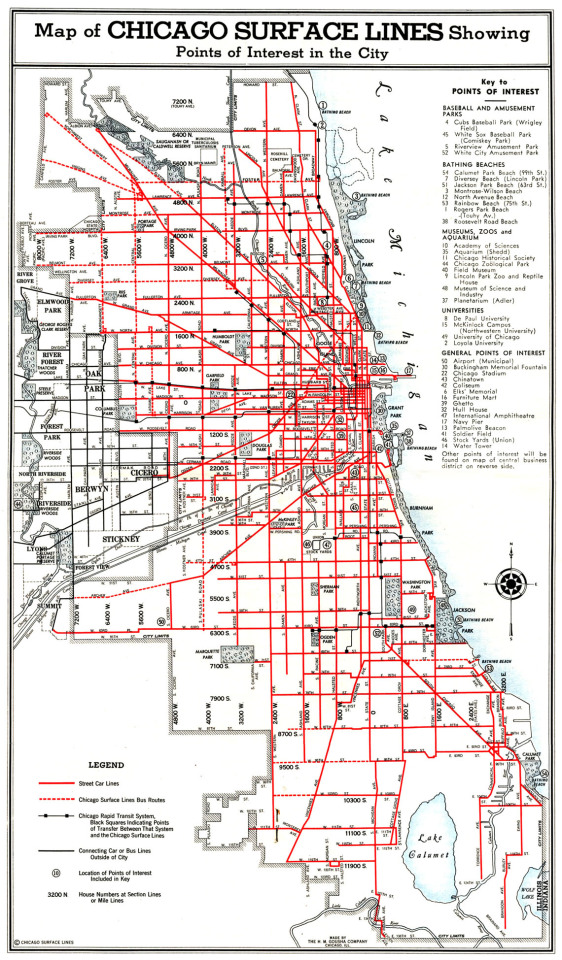
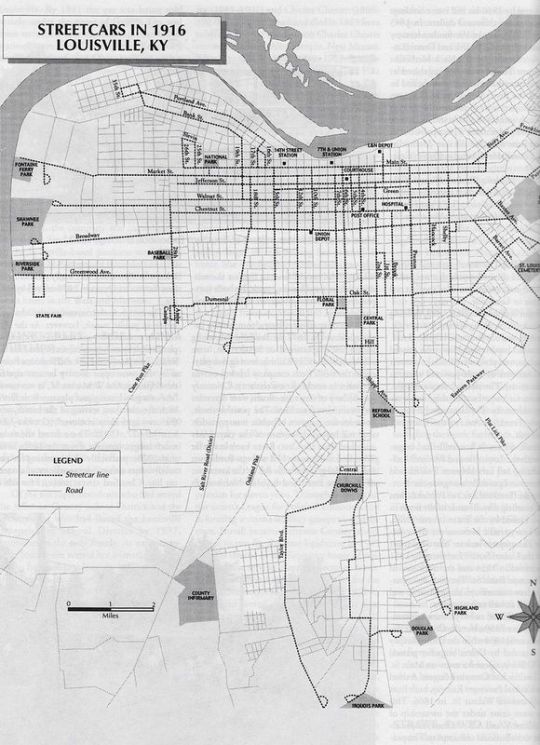
(Above are historic streetcar maps of 6 US Cities, shown top to bottom, left to right, they are: st. Paul, Cincinnati, Detroit, Columbus, Chicago, Louisville)
3K notes
·
View notes